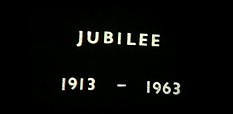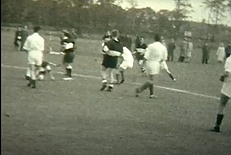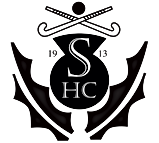
STEPPS HOCKEY CLUB
1913
The History of Stepps Hockey Club.... So Far!
Over the past 100 years plus, people have come and gone, faces have changed, hair has disappeared, stomachs have appeared, ladies teams have arrived, then left, then come back again, but Stepps Hockey Club has remained. Here's some history of the club we love...
1913-1945 - The Early Years
It has never been ascertained with any degree of accuracy why a club was formed in Stepps specifically for the playing of the game of hockey, but the very first minutes, written in pencil and still legible on a writing pad, aptly named "Challenge", states quite clearly and definitely that at a meeting held in the Union Public Hall on 15th April 1913, "it was decided to form a hockey club in Stepps".
The eight gentlemen who attended that historic meeting and who most assuredly were the founder members of the club were;
A. D. Montgomery (Chairman), R. Auber, J. Barnett, F. Cook, E. C. Hart, R. M. Pitcairn, J. Stewart and B. Wallace.
The establishment of Stepps Hockey Club, should to digress a little, perhaps be shown in relation to the national pattern in Scotland.
Although shinty existed as a pastime in the country, it was not until the late 19th century that hockey emerged as a game, with an agreed code of rules. The first recorded hockey match was between Fettes and Loretto schools in 1891. Thereafter, within a few years men's clubs commenced here and there in the country, and this culminated in 1901 when an association of Western clubs held a challenge match against Eastern clubs, and later that same year a national meeting was called and the Scottish Hockey Association was formed. The affiliated clubs at that time were:
Band of Brothers, C. G. Addis XI, Clackmannan County, Dumbarton, Edinburgh, Edinburgh University, Milliken Park (now Cochrane Park) (now Kelburne), Nondescripts, Royal Artillery (Leith), Western
In the next dozen years the game flourished and spread rapidly.
International matches were played, District Associations were constructed, although a West District had been in existence since 1900.
More and more clubs were formed, until 1914 when war put a stop to further expansion of the game.
It was therefore during this period of growth of the game of hockey that somebody in Stepps thought it a good idea to form a club, gathered a few enthusiastic like-minded gentlemen around him, and called the afore-mentioned meeting.
The meeting next proceeded to the election of Office Bearers who were;
President P. Edgar
Vice-President E. C. Hart
Secretary & Treasurer J. Barnett
Club Captain A. D. Montgomery
Committee Members H. Riach, R. Auber, F. Cook
and J. Stewart
Certain 'influential gentlemen', as the Minute puts it, were thought to be suitable to be appointed Hon. Office Bearers and they were to be approached to fill the positions.
Hon. President Col. A. Sprot
Hon. Vice Presidents R. J. Dunlop, R. Love W.C.B.
Christie and Dr. A. McGuire
The pitch suggested was next to Stepps Cricket Club ground which was very roughly where the pitches are today. The rent was £2.10.0d. to be paid annually to Mr. Pettigrew, the farmer. At the same time 10/- a year was to be paid to the Cricket Club for the use of their pavilion and entrance to the ground.
Goal posts were to be bought and erected for 8/- and the first match was arranged against Babcock and Wilcox, to be played on 29th April.
Thus Stepps Hockey Club was born, on paper at least!
According to the minutes of the first AGM, held on 2nd September 1914, the first season was a most successful one in various ways. So many people wanted to join the club that a 2nd XI had to be formed and fixtures arranged for them. Twenty four matches were played by the 1st XI, 14 were won, 6 lost and 4 drawn - 'a record for a first year club' states the Secretary's Report. However problems arose which were to remain problems for many years e.g. condition of pitch and clubhouse facilities. Negotiations with various people ultimately resulted in 'The Moss' being rented from Mr Morton of Whitehill Farm. Various functions were held to raise money to erect a Pavilion which was eventually to be erected for the princely sum of £29.
With the outbreak of the First World War the playing of the game of hockey became of secondary importance, but the club carried on as best it could under the circumstances.
There are no records of any meetings having been held between
November 1914 and September 1919.
The first minute is of an AGM held on 2nd September 1919 when it was unanimously decided to re-establish the club as quickly as possible and to that end the following office bearers were elected;
Honorary President Wm. Watson, JP
Honorary Vice Presidents R. Rankin, Dr. McGuire, J. Jack,
H. Riach, Rev. J. Fleming,
Rev. M. Sherman
President Peter Edgar
Vice Presidents John McEwing, John Campbell
Captain Paul Johnstone
Vice Captain John Barnett
Hon. Secretary Matthew Johnstone
Hon. Treasurer William Fraser
Committee Members Robert M. Smith, Jarnes Knox
Arthur Allan
Selection Committee John Campbell, John McEwing
The playing membership in the clubs first season after the war exceeded 30, with two Xl’s being run successfully. 1st XI played 21 matches, won 12, lost 4 and drew 5.
Once again the pitch was proving unsatisfactory, and approaches were made to the local farmers with a view to a change being made. Whitehill and Hornshill Farms proved negative. A field was offered at the foot of Lenzie Brae at £6 per acre, per annum for a period of 10 years, but this was declined. Finally, after months of searching and negotiation with all sorts of people it was decided to return to Mount Harriet. The ground was to be leased for 10 years from Sir Alex Sprot at £20 per annum, with powers to sub-let it for grazing at a rate of £7 per annum.
For some reason or other a sum of £2 had to be paid to Mr Pettigrew the farmer "for access to the ground"!
Just to prove also how well the local residents supported the club there is also a list of no fewer than 60 of them - all Honorary Members.
The next ten years, until season 1934-35, saw the fortunes of the Stepps club, in a playing sense at any rate, fluctuate quite considerably - some very good, some not so good and some, by Stepps standards, very bad.
But season 1934-35 was an historic season in another sense, as it was during that season that the first player from the club was capped for Scotland. Hugh Watson played at outside right in all three internationals against England, Ireland and Wales. In his secretary's report to the AGM at the end of that season Jack Ferguson expressed the wish that "now that a start had been made Stepps will be represented in Scottish teams for years to come".
The following season saw Hugh receive one more cap, against Wales, but more importantly George Abel, ('Dot' to most of us), received long overdue recognition by not only being capped against Wales but also by being selected to captain the Scottish team. Many followers of the game
felt that his ability as a forward should have been recognised earlier in his career, but the selectors of that era were prone to selecting players from shall we say, more fashionable clubs, and many from English clubs, to the exclusion of home players, many of whom, and Stepps had others, were considered to be at least as good as, if not better than those selected. Dot Abel only received the one cap at left back in which position he played for the club until the end of his playing career.
Season 1936/37 saw George Sime receive his only pre-war cap, at right back against Wales. George of course played for Scotland, and Great Britain after the 2nd World War and these caps will be dealt with in the next section.
It was during the mid 30's that the Stepps club reached peak performance. In two of these seasons the first eleven produced records which have stood the test of time.
Most, if not all, of today's players assume that competitive hockey with its leagues and cups was post-war innovation. That however is not the case, for as far back as 1938 an "unofficial league" was run by the Glasgow "Evening News", and although not all the clubs in the west played each other twice during the season sufficient matches were played to give a pretty accurate picture of the playing strength of the clubs involved. Very little separated the like of Stepps, Cartha, Western, Whitecraigs, Nomads and others, but perhaps season 1937/38 is worth mentioning as it was the year that Whitecraigs and Stepps finished equal first in pointage, and as it was generally felt that goal average/difference was not a suitable way of deciding the winner a decider was played at Mount Harriet in April 1938 which we unfortunately lost 0-1 after a very keenly fought match. The Stepps team which played in that match, and which is the team referred to earlier as having been one of the club's strongest of that particular period was:-
George Baird, George Sime, George Abel, Alastair Murray, Jack Ferguson, 'Currie' McCartney, Hugh Watson, Willie Russell, Bryce Thomson, George Paterson and Alex Robertson.
The club was able to carry on for two more seasons, but with the outbreak of the Second World War and the consequent departure of many players to the Armed Forces, it was considered to be impossible to continue playing and the interests of the club were put in the hands of a War Emergency Committee comprising:
Chairman: A. G. Abel
Secretary: J. Ferguson
Members: G. D. Paterson, B. Johnstone and J. Brackenridge
A big debt of gratitude is due to all these gentlemen, but particularly George Abel, for keeping things ticking over during the six years of war. Unfortunately the clubhouse was burned down on 19th May 1943, but £100 was paid by the Insurance Company so at least the club funds benefited!
With the mention of the loss of the clubhouse it is perhaps pertinent at this stage to point out to today's players how fortunate they are in having such comfortable accommodation available to them. In these pre-war days the home team stripped at home and walked up to the pitch, because there was only room for the visitors. There were no showers - in fact no water was laid on at all, and basins were supplied for the visitors to help themselves to water from the rain barrel outside!
On some occasions water had to be brought from 'Ulston', which in those days was occupied by the Paterson family.
Lighting, toilet and cooking facilities were also basic, and very often ladies making the tea were confronted by near naked men prancing about the place to get some heat up after their ablutions!!
It is worth noting also that the Stepps captain, of whichever eleven was playing at home, was responsible for persuading a lady to deal with the visitors tea - for purchasing the food (usually from Gillies and McNish), and for remaining to socialise with the visiting team during tea, whether or not his strip was muddy and soaking wet.
So the club was in 'mothballs' until the end of hostilities in 1946, when those who were fortunate enough to return to civilian life, and were still young enough to play hockey, together with a new generation of youth, keen to help to get the club going again, worked with those who had watched over the club's interests during six years of war to make Stepps Hockey Club once again one of the leading clubs in Scotland.
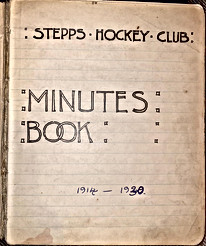
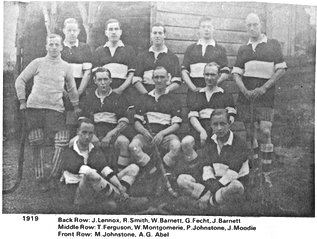
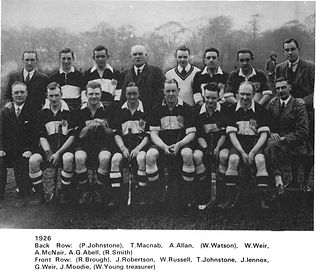
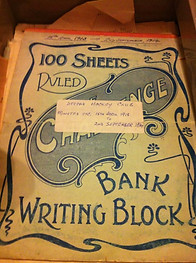
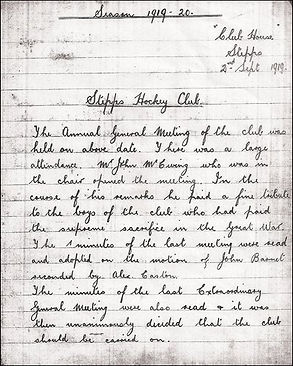
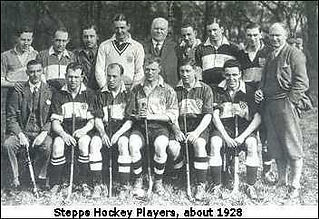
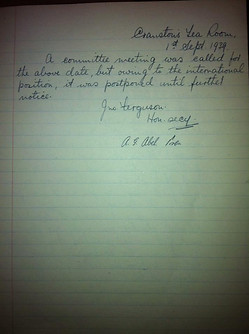
1946-1956 - Rebuilding & Development


During the ten years covered by this section the playing side of the club was largely overshadowed by the enormous amount of work which had to be done to improve the playing facilities. The pitch at Mount Harriet had received the minimum maintenance during the war years and consequently was in a very poor condition, at the same time the lack of a clubhouse created very serious problems.
The magnitude of the playing field problem was obviously not realised, as the first post-war AGM minute merely states that 'it was decided to proceed with the repairing of the drains immediately! - Members to carry out drain repairs themselves'. At the same time it was decided to purchase a surplus railway coach for \:20 and to have it converted into a pavilion. This purchase was later changed to two Highland Railway brake vans each measuring 20' x 8’ x 8' at £20 each. This arrangement was made possible through the good offices of Mr G. Millar who also kindly offered to draw up the necessary plans which he thought would be needed to convert the vans into a pavilion.
Within a year the vans having been duly transported and manoeuvred into position doubts were being expressed as to whether or not the scheme would work or whether a completely new pavilion should be purchased.
Also at this time a completely new suggestion was made to the club regarding the pitch. D. Pollock-Smith. who over the years was to assist the club in so many different ways suggested that a completely new pitch should be built at the north end of Mount Harriet, and that a start could be made by allowing the County Council to deposit the road slag from their road widening operations to be dumped in the area so raising it to the required height. This suggestion was accepted in the long term, subject to cost and feasibility.
It was at this point that the help and professional advice of Forbes Campbell was sought and freely offered. After an initial survey he agreed that the long term policy was indeed feasible and offered to take in hand a complete survey of the area, and thereafter to draw up detailed plans of his suggested layout, following which an approximate costing could be undertaken.
At the same time the pitch decision was being taken it was agreed that the railway vans could not be converted to a pavilion and they were subsequently sold. Thanks to the good offices of J. C. McGrouther. D. Pollock-Smith, and the valuable co-operation of J. L. Freeland , the headmaster, the use of Stepps Public School as a pavilion was obtained.
Prior to season 1948/49 the deterioration of the existing pitch had become so great that it was considered to be unfit for play unless urgent actions were taken. A firm of ground contractors was immediately instructed to repair the drains on the south side of the pitch. At the same time consideration was given to moving play to Stepps Stadium, but after investigation this was found to be impossible.
Over the next three years work on the new pitch went ahead as planned, the chief driving force being D. Pollock-Smith, who saw to it that all surplus material from County Council schemes, such as road widening and pipe laying, was dumped at Mount Harriet, until the level of the new pitch had been built up to a satisfactory level. At the same time money had to be spent on the drainage and surface of the existing pitch.
Application was made to various bodies for grants, without success, while various fund raising schemes were organised, including a jumble sale and garden fete - held in the grounds of Garfield House - resulting in a grand total of £700 being raised towards the cost of the reconstruction scheme.
An up-to-date report on the cost of completing the scheme was undertaken in January 1952 by Martin Smith, whose estimate amounted to £2490, excluding cost of supervision, equipment and any work outwith the playing pitch and immediate surround. With only approx. £700 raised for the reconstruction work, and costs rising annually, it was decided that, without grants, and the slow rate at which funds were being raised in spite of a lot of hard work by a lot of people, that the club could never meet the cost of the reconstruction scheme as envisaged by Forbes Campbell, and a complete re-assessment of the position was urgently required.
After various meetings between the club president, Bryce Thomson and County Councillor D. Pollock-Smith a feasible scheme emerged. The club would offer the whole ground to the County Council, together with the £700 in the fund, with the request that they complete the construction work, and give the club a suitable long term lease, at reasonable cost, so that the game of hockey could continue to be played at Mount Harriet for many years to come.
This scheme was put to a meeting, not only of members of the club, but many residents who were keen to help in many ways to keep the club in being. That meeting unanimously approved the scheme, and D. Pollock-Smith thought it had every chance of success. A small sub- committee was elected with full power to carry out the negotiations with the County Council until a suitable lease was negotiated.
That committee was:-
Bryce Thomson - Club President
George Black - Club Secretary
William Dollar - George J. L. Thomson
Most of the work of this committee was of a complicated legal nature, and the club owes a very great debt to William Dollar, whose patience and meticulous attention to detail ultimately resulted in a very satisfactory 20 year lease being negotiated between the club and the Ninth District Council, giving the club the full use of the pitch for the playing of the game of hockey only - with first option to renew when this expired, the annual rental being a mere £15.
With the legal aspect now brought to a satisfactory conclusion, and the retention of Mount Harriet secured, at least for the next 20 years, attention now turned more towards the completion of the reconstructed pitches so that Stepps Hockey Club could look forward to a stage in their history where their playing surface would compare favourably with some of the best in the land, and they would finally lose the accusation "that Mount Harriet was a 'peat bog' and worth two goals of a start to Stepps".
The playing performance of both Xl's over this period was very
ordinary, but with many games being cancelled because of the condition of the pitch, plus the distraction of the building of the new pitch, and a struggle to maintain the membership, it is not surprising that there was considerable lack of enthusiasm. However, all was not 'gloom and doom', as over this period the club had more players 'capped' for Scotland than at any time during its seventy-five years.
George Sime not only captained Scotland in each of the matches played during 1948, 1949 and 1950, he also received the highest honour ever accorded to a Stepps player by being chosen to play in the Great Britain team which played in the 1948 Olympic Games in London. The Great Britain side unfortunately lost to India in the final but nevertheless, George is the proud possessor of an Olympic Silver Medal. A reward which he richly deserved.
Commencing in 1953 an annual match between a Home Scots XI and Ulster was played and here again Stepps players were involved, especially Bill Milton who played each year from 1953-1956. Others were George Black, Ronnie McClure and Mike Kirkland. Others were to follow in later years.
In the umpiring field too Stepps men were beginning to break through into the international field.
During this period too, our officials were being appointed to administrative positions within the Scottish Hockey Association.
George Baird was Match Secretary during the three years 1949-1951, while Jack Ferguson was appointed an International Selector in 1955. At the same time as holding these positions at national level both were serving in various capacities at club and district level. This created a precedent which was to be carried on by other club officials in future years.
The official opening of the new ground at Mount Harriet took place on Saturday 1st May 1954 and was performed by the then president of the Scottish Hockey Association Mr. W. F. M. Whitelaw. A match between Stepps and an SHA Presidents XI inaugurated the new playing field, followed by a dinner in the Grosvenor Restaurant in Glasgow. The Stepps team which took part in this historic match was:
George Black, Basil Fraser, Mike Kirkland; Gordon Kirk land, Bill
Milton, Bill Currie; Jim Carnpbell, Alan MacKenzie; Ronnie McClure;
Ronald Anderson and Gordon Farquhar. Ronnie McClure had unfor-
tunately to withdraw because of injury and his place at centre forward was taken by Bilyl Robertson. Jack Ferguson and Bryce Thomson umpired, and although Stepps performed creditably, they lost 3-1. Season 1954/55 was significant in the club's history for two other reasons. The first was the establishment of a very enthusiastic Ladies Section, whose teams played on the blaes pitch to the south of the main pitch, and the second was the decision of the West District to agree to competitive hockey being played, the format being a percentage league table along the basis of the one operating in rugby circles. This decision was the result of a long campaign fought by the club against very strong opposition, and was the forerunner of the national league and cup competitions in existence today. The man who represented the club at various meetings and who put so much work into the change he passionately believed in was Jack Lumsden, of whom it can truly be said
he was the creator of competitive league hockey in the west of Scotland.
The climax to the ten years of rebuilding and redevelopment must surely have been during season 1955/56 when the SHA requested permission to play their international against Wales at Mount Harriet on Saturday 28th April 1956. Stepps readily granted permission and a most successful match took place with local interest being centred on George Black who was in goal for Scotland. Such a success was made of this match by the club that letters of congratulations and thanks were received from both the President and the Secretary of the SHA.
On this high note ended a very difficult period in the club's long history, but now firmly established as a leader in all sections of hockey, as players, umpires and administrators, the Stepps club went forward confidently into the next decade, which was to prove as successful in all aspects of the game.

1956 - 1964 - Hot Showers & Jubilee Year
During the late fifties, the clubhouse facilities were to improve greatly with the announcement that the local council had purchased a builders' hut from Messrs. Mowlem , for use by the club as a pavilion. This hut was made available to the club for the start of season 1957-58.
Improvements to the pavilion were made over the following years, particularly in season 1959-60, when the club raised sufficient funds to finance an extension. This extension included such previously unheard of luxuries as hot showers. It should perhaps he noted that the club not only financed the extension, but also assisted in its erection.
Season 1962-63 saw an increase in the number of playing members, resulting in the formation of a 3rd XI.
The following season saw the club celebrate its Jubilee (see https://www.youtube.com/watch?v=DZSOwsxb9XM) with a highly successful match at Mount Harriet against and SHA XI followed by a celebration dinner at the Grosvenor Hotel. This season also saw George Black gain four Great Britain caps during the team's tour of India. He also received the Usher Vaux Sports Award for 1963.
Season 1963-64 also saw the 1st XI placed in West District league Division II following restructuring of the league. The team added to the Jubilee celebrations by Winning Division 2. This success was something of a turning point in the club's fortunes with new young players coming into the 1st XI. The club went on to win West District league Division 1 within two seasons, thus starting the most successful period in the club's history.
